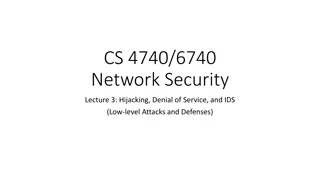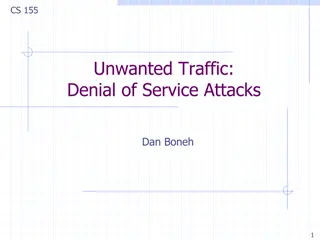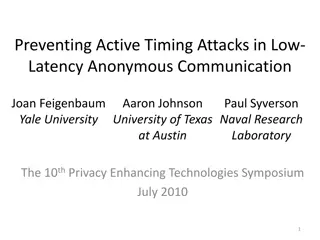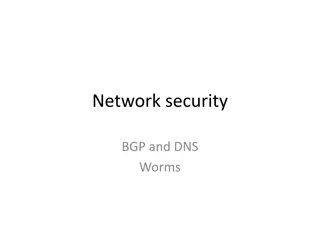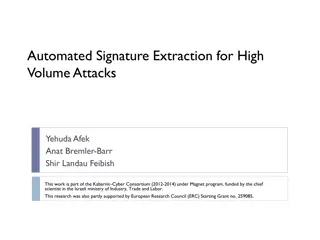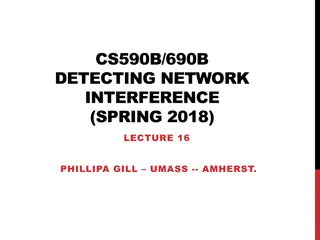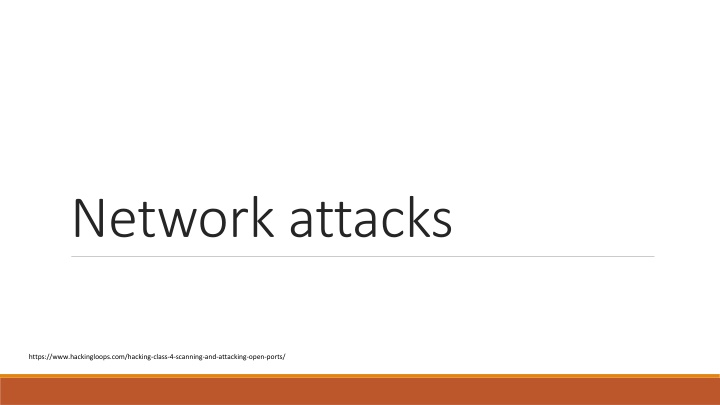
Network Communication Layers and Protocols
Explore the intricacies of network communication through layers like Application, Transport, and DataLink. Delve into TCP/IP communications, data formats, and the significance of studying networks for protection against potential attacks.
Download Presentation

Please find below an Image/Link to download the presentation.
The content on the website is provided AS IS for your information and personal use only. It may not be sold, licensed, or shared on other websites without obtaining consent from the author. If you encounter any issues during the download, it is possible that the publisher has removed the file from their server.
You are allowed to download the files provided on this website for personal or commercial use, subject to the condition that they are used lawfully. All files are the property of their respective owners.
The content on the website is provided AS IS for your information and personal use only. It may not be sold, licensed, or shared on other websites without obtaining consent from the author.
E N D
Presentation Transcript
Network attacks https://www.hackingloops.com/hacking-class-4-scanning-and-attacking-open-ports/
Why study networks? As we will see in attack models (e.g. Mitre), there is a step called Discovery Discovery. The adversary is trying to figure out your environment. Network scans are the most prevalent method of understanding your environment, with intent to use that information to run exploits To understand how to protect your system, you have to understand how the system works!
How do computers communicate? The 7 layers are the classic OSI 7 layer model https://www.electronicdesign.com/unused/article/21800810/whats-the-difference-between-the-osi-sevenlayer-network-model-and-tcpip
A crash course in network communication 7 Application Works with applications to provide communications & functions Applications (FTP, HTTP, SMTP etc) 6 Presentation ensures compatibility between the data formats from lower to upper layers 5 Session Establish connection between devices (also maintain, authenticate ) 4 Transport TCP Quality of service, data integrity 3 Network IP Packet routing (IP address (source/ destination) and port) to socket 2 DataLink Pack/ unpack data frames (MAC source/ dest) unique identifier Ethernet 1 Physical Physical connection, data rates, bit level handling Modern Network/ Internet Model Classic OSI Model OSI 7 layer model vs modern internet
TCP/ IP Communications Application Application Transport Transport Router Router Network Network Network Network Dest. computer Source computer DataLink DataLink DataLink DataLink In a typical network, computers are on subnets, and routers are used to transmit from subnet to subnet
Data formats (TCP) 4 octets (32 bits) Source Port Destination Port Header (20 octets) Sequence Number Ack Number Data offset Reserved Flags Window Checksum Urgent Options and padding Data (variable size) Down at the low level, packets are organized to tell the nodes on the network who is sending, receiving, etc. These are the datapackets that are manipulated to scan networks Derived from multiple sources
Network attacks Ports are the endpoints of network communications Software programs listen on numbered ports. Network attacks target the lower levels of communication (above the datalink) and create low level communications to the ports Frequently packet manipulation is used to trigger special behaviour Scans and attacks understand which ports support what application and how the responses are supposed to be handled They take advantage of how implementation handles packets and tries to bypass or interrogate responses
PORT SCANNING PORT SCANNING Network ports are the connections used to send data packets Scanning is a mechanism used to interrogate devices and networks How is this information used by attackers? To detect the live systems running on the network. To discover which ports are active/running To discover the operating system running on the target system (fingerprinting) To discover the services running on the target system To discover the IP address of the target system.
What are some types of scans? Port Scanning: There are 64k ports in a computer out of which 1k are fixed for system or OS services. In Port scanning we scan for the open Ports which can be used to attack the victim computer. A series of messages are sent to break into a computer to learn about the computer s network services. Through this we will know that which port we will use to attack the victim. Network Scanning : Network scanning is basically a procedure of finding the active hosts on the Network. e.g. We tries to find that system is standalone or multiuser. This is done either for the purpose of attacking them or for network security assessment i.e how secured the network Is. Vulnerability Scanning : As from the name , In this type of scanning We scan the systems for finding the vulnerability i.e the weakness in OS/database. Once we find the vulnerability or loop hole we can utilize it to best..and attack the victim through that.
How port scans work Depending on the packet sent and the flags set, the port scanner looks for responses and makes guesses on the configuration and state of the port(s) Probe Response Assigned State No response received (even after retransmissions) open|filtered TCP RST packet closed ICMP unreachable error (type 3, code 1, 2, 3, 9, 10, or 13) Filtered Full response [ack etc.] open
Common ports 21: ftp 445: microsoft-ds 22: ssh 993: imaps 23: telnet 995: pop3s 25: smtp 1723: pptp 53: domain name system 3306: mysql 80: http 3389: ms-wbt-server 110: pop3 5900: vnc 111: rpcbind 8080: http-proxy 135: msrpc 139: netbios-ssn 143: imap 443: https
SYN Scan Mini Network tutorial: The SYN [synchronize] flag is the TCP packet flag that is used to initiate a TCP connection. A packet containing solely a SYN flag is the first part of the "three-way handshake (SYN; SYN- ACK; ACK) of TCP connection initiation. It is responded to with a SYN-ACK packet. TCP Packet is sent with SYN flag set Response from the target is monitored If ACK, then port is open If RST, then port is closed If no response, then might be filtered, closed or other
Other simple scans FIN Scan The FIN scan sends a packet that would never occur in the real world. It sends a packet with the FIN flag set without first establishing a connection with the target. If a RST (reset) packet is received back from the target due to the way the RFC is written, the port is considered closed. If no packet is received at all, the port is considered open. NULL Scan NULL scans also send a packet that should never occur in the real world. It does not set any flags on the TCP packet and fires it at the target. Like above, a RST packet response means it s a closed port no response is considered an open port. ACK Scan The ACK scanning method is used to determine whether the host is protected by some kind of filtering system. In ACK scanning method, the attacker sends an ACK probe packet with a random sequence number where no response means that the port is filtered (a stateful inspection firewall is present in this case); if an RST response comes back, this means the port is closed If one Scan doesn t work try something else! (Hackers are very persistent). Sometimes special flags (like PSH or URG) are used to force responses
Xmas tree attack example A sequence of network packets alternating special flags (simulates blinking lights on a tree) - PSH - URG - FIN Attempts DoS due to higher processing required for these flags Tries to identify open ports If the port is open on the target system then the packets will be ignored (illegal flags). If closed then an RST will be sent back to the individual running the scan.
Wireshark The most widely used network monitoring tool https://www.wireshark.org/#download Invaluable for monitoring, investigating networks and network attacks Exercise: Investigate Network trace and look for clues/ conclusions
Tools Many tools are available to facilitate scanning computers and networks. One of the longest-lived tools is nmap (http://nmap.org/dist/nmap-5.00-setup.exe) Features of NMAP : Nmap is used to carry out port scanning, OS detection, version detection, ping sweep, and many other techniques It scans a large number of machines at one time. It is supported by many operating systems. It can carry out all types of port scanning techniques.
Nmap command examples 1. Basic Nmap Scan against IP or host nmap 1.1.1.1 2. Scan specific ports or scan entire port ranges on a local or remote server (you can scan multiple addresses, ranges etc) nmap -p 1-65535 localhost This will scan 256 IP addresses from 8.8.8.1 to 8.8.8.256. 3. Scan the most popular ports Using top-ports parameter along with a specific number lets you scan the top X most common ports for that host, as we can see: nmap --top-ports 20 192.168.1.106 Replace 20 with the desired number. Output example: 4. Scan + OS and service detection with fast execution Using the -A parameter enables you to perform OS and service detection, and at the same time we are combining this with -T4 for faster execution. See the example below: nmap -A -T4 cloudflare.com 5. Detect service/daemon versions This can be done by using -sV parameters nmap -sV localhost https://securitytrails.com/blog/top-15-nmap-commands-to-scan-remote-hosts
Nmap examples (contd) 6. CVE detection using Nmap One of Nmap s greatest features that not all the network and systems administrators know about is something called Nmap Scripting Engine (known as NSE). This scripting engine allows users to use a pre-defined set of scripts, or write their own using Lua programming language. Using NSE is crucial in order to automate system and vulnerability scans. For example, if you want to run a full vulnerability test against your target, you can use these parameters: nmap -Pn --script vuln 192.168.1.105 7. Detecting malware infections on remote hosts Nmap is able to detect malware and backdoors by running extensive tests on a few popular OS services like on Identd, Proftpd, Vsftpd, IRC, SMB, and SMTP. It also has a module to check for popular malware signs inside remote servers and integrates Google s Safe Browsing and VirusTotal databases as well. A common malware scan can be performed by using: nmap -sV --script=http-malware-host 192.168.1.105 Or using Google s Malware check: nmap -p80 --script http-google-malware infectedsite.com Nmap is one of the most complete and accurate port scanners used by infosec professionals today. With it, you can perform simple port scan tasks or use its powerful scripting engine to launch DOS attacks, detect malware or brute force tests on remote and local servers.
Sample output of a scan root@kali:~# nmap -O 192.168.5.102 Starting Nmap 7.01 ( https://nmap.org ) at 2016-03-04 21:16 CET Nmap scan report for 192.168.5.102 Host is up (0.30s latency). Not shown: 977 closed ports PORT STATE SERVICE 21/tcp open ftp 53/tcp open domain 80/tcp open http 88/tcp open kerberos-sec 111/tcp open rpcbind 135/tcp open msrpc 139/tcp open netbios-ssn 389/tcp open ldap 445/tcp open microsoft-ds 49152/tcp open unknown 49153/tcp open unknown 49154/tcp open unknown 49155/tcp open unknown 49157/tcp open unknown 49158/tcp open unknown Device type: general purpose Running: Microsoft Windows 7|2012|XP OS CPE: cpe:/o:microsoft:windows_7 cpe:/o:microsoft:windows_server_2012 cpe:/o:microsoft:windows_xp::sp3 OS details: Microsoft Windows 7 or Windows Server 2012, Microsoft Windows XP SP3 OS detection performed. Please report any incorrect results at https://nmap.org/submit/ . Nmap done: 1 IP address (1 host up) scanned in 153.47 seconds Notice how ports are identified and state is listed









